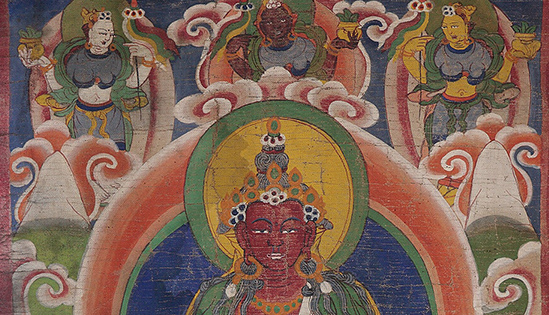Tanka Collection
A collection of tankas, which are Buddhist scrolls or fabric temple banners

Tankas, also known as thangkas, are hanging scrolls or fabric temple banners that consist of a painted picture panels (called mélong in Tibetan, which means ‘mirror’), usually depicting buddhas, mandalas, or great practitioners, which are sewn into or bordered by a textile mountings. Tankas are intended to serve as records of, and guides for, contemplative experiences and visualizations.
The Collection
The collection consists of 77 tankas, chiefly Tibetan, but also Nepalese, Bhutanese, Indian and Chinese, which bear religious images, circa 1600-circa 1950. Some tankas also bear inscriptions on their versos.
Divinities represented in the collection include Akṣobhya, Amitābha, Amitāyus, Avalokiteśvara, Bardo Thodol deities, Bhaiṣajyaguru, Dorje Shugden, Garwai Nagpo Damchen, Hayagrīva, Mahākāla, Palden Lhamo, Prajñāpāramitā, Rāhula, Sitātapatrā, Tārā, Vajrabhairava, Vajrapāṇi, Vajrasattva, Vajrayoginī, Vasudhārā, and Viśrāvaṇa.
Buddhist practitioners with portraits in the collection include Gautama Buddha, his arhats (disciples), Kloṅ-chen-pa Dri-med-‘od-zer, Lobsang Chökyi Gyaltsen, Mi-la-ras-pa, Ṅag-dbaṅ-blo-bzaṅ-rgya-mtsho, Padma Sambhava, Tsoṅ-kha-pa Blo-bzaṅ-grags-pa, and Yungtön Dorjepel, as well as unidentified Karmapa abbots and an unidentified Sa-skya-pa lama.
Portrayals of inanimate objects and locations include srid-pa-ho (astrological divination charts), a srid-pa’i-‘khor-lo (wheel of life), rgyan-tshogs (offerings), a stupa and a mandala.
Identified artists in the collection consist of Tsewang Norbu, an artist active in Darjeeling, India, circa 1865, as well as Rin-zin (or Rig-zin), a artist active in Sikkim, India, circa 1950.